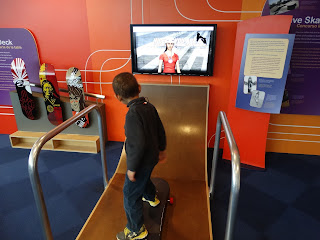The snake game is quite an interesting material and is a fun way to learn the different ways that you can make the number 10. The child lays out a combination of bead bars in any order in the shape of a snake (or zig zag).
Here is a sample snake that Bubs worked on today. You can see the three sections of the material. The left box has the 10 bars which will be used for exchanging. The middle box has colored beads for making the snake. The right box is for the beads for the black stair. The black stair is used as a place holder when counting.
He starts counting each bead bar until he reaches 10. In the picture above, there is a 3 bar, a 5 bar, and a 4 bar. The red pick thing (Ok, I don't know what it is called, but it looks like a guitar pick!) holds the place for the child while he gets the 10 bead for exchanging. So, 3+5+2 is 10, but you still have 2 more beads which are part of the 4 bar. That is why the red pick is in between the beads on the 4 bar.
Here, Bubs has gotten a 10 bar (which takes the place of the 3 bar, 5,bar and 2 of the beads from the 4 bar). He took the 2 bar from the black stairs to represent the last two beads from the 4 bar. Now he will put the 3, 5, and 4 bar in the cup on the right to show that he has counted them. He then starts to count again up to 10, starting with the black 2 bead bar.
He continues through the snake, exchanging for 10 bars along the way.
When he is finished, and has worked with it for some time, he does the extension of checking his work. He places the 10 bars that he exchanged at the top of the mat. Then he lays out all of the bead bars that he counted from the cup underneath the 10 bars. He lays them out from smallest to largest, notice the 1 bar on the far left side.
To start checking his work, he places the largest bead bar (9 in this problem) next to the 10 bar. Then he looks to see how many more beads he needs to equal 10. He needs a 1 bar. He takes it from below. Then he takes the next largest bead bar (8) and moves to the next 10 bar. He sees that he needs a 2 bar, but only has a 3 bar. He then exchanges his 3 bar for a 2 bar and a 1 bar from the middle box above. Then he adds the 2 bar to the 8 bar to make 10.
He continues with the 7 bar and using the 4 bar below to exchange for the 3 bar needed.
He keeps exchanging,
Yay!!! He ended up with no beads left over. So how many beads did he count? 50 (There are 5 10 bars.) He was very excited to get his answer right because this meant that he could go upstairs for snack! Stay tuned for the negative snake game hopefully soon.



























